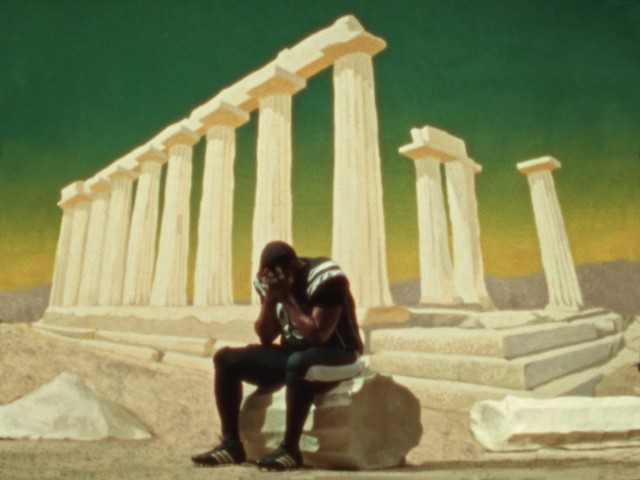Guy Kozak’s End Zone is something like a fever dream without the consequence. At the baseline, this is a simple story about a young football player that sustains a head injury, but it’s presented through a surrealistic lens that makes it one of the most inventive shorts we’ve featured in sometime. Everything (production-wise) at work in End Zone creates a delightful disorientation for the viewer, as we plunge into the, presumably, concussed protagonist’s (Player 13’s) dream state. Shot on film, the visuals are beautifully sweaty and dense, with overlays and non-cohesive edits blending together harmoniously to deliver a truly unique experience.
Spending most of its duration in la-la land, End Zone has a setting that’s hard to place. The glowy grain of 16mm film lends both a timeless quality and a nostalgic vibe, adding to that temporal ambiguity – a quality I enjoyed greatly, as it smartly lends to the dreaminess of it all. In his notes on End Zone, Kozak gives light to his choice of using Kodak Ektachrome color reversal stock, explaining that is was the same film used in the NFL’s early football documentaries. This fact makes me want to place the football sequences in a bygone decade, an impression reinforced by the score for the kitchen sequence later in the film. However, the reference to current football star Aj Howard pulls us back to the present. This playful manipulation of time is well-executed and something to applaud. On a deeper level, End Zone feels like a commentary on today’s easy access to and immersion in the past, which can serve as an escape from reality.

Kozak’s production aimed to use practical effects “whenever possible”, including “large-scale hand-painted backdrops”.
After a 70-second exposition that immerses us in the world of End Zone, and a brief, psychedelic title sequence, we find ourselves alone with Player 13 in a black abyss. Emerging from the darkness, a referee with a bizarre, rhythmic walk traces the breathless and anxious Player 13 with chalk. The referee’s Lynchian presence isn’t surprising, given Kozak’s admission that David Lynch, along with Fassbinder and Cocteau, inspired him. The frames that follow are entirely original and unlike anything I’ve seen before. There’s a perfect blend of goofy irony that makes me smile, but the imagery never crosses a line into purposeless weirdness.
Kozak sets his film against the stereotypical notions of sports, explaining: “American Football has been a long-term fascination for me, along with all of the pageantry, drama, violence and mythology that goes with it. At the core of this film is the idea of football as theater, complete with a stage, music, choreographed movement, an audience and actors”. The backbone of End Zone is clearly rooted in feelings, essence, textures – elements typically expressed through art, so the logistics of football add a fascinating dynamic. However, this isn’t a film about portraying football as artistic. Instead, it serves as an aesthetic flex, encouraging viewers to reflect on film as a form and ponder the nature of football itself.
